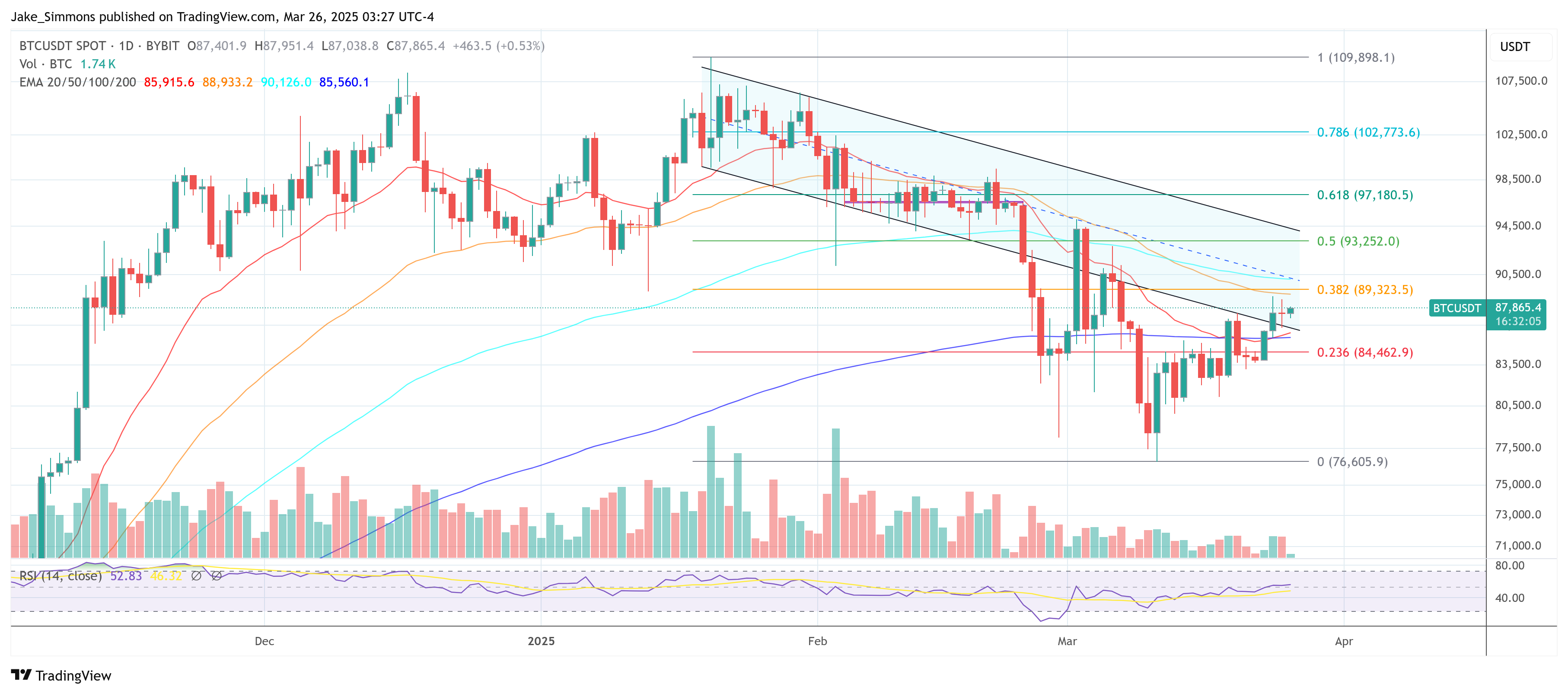Reason to trust

Strict editorial policy which focuses on precision, relevance and impartiality
Created by industry experts and meticulously revised
The highest standards in the declaration and publishing
Strict editorial policy which focuses on precision, relevance and impartiality
Leo football price and a little soft players. Each Arcu Lorem, ultimate all children or, Ultlamcorper football hates.
In his latest investor note, entitled “The Great Derisking of Bitcoin”, the management of Bitwise assets has taken a daring position on the future of the original cryptocurrency of the world. The director of investments, Matt Hougan, delivered a detailed analysis in a dispatch dated March 25, 2025, declaring: “It is now the best time in history to buy bitcoin (on a basis adjusted at risk).” THE notewhich includes reflections on the beginnings of Bitcoin and an assessment of its greatest stages, explains why Bitwise believes that the risk profile of the leader leader has changed considerably in recent years.
Best time to buy bitcoin
In his opening remarks, Hougan recounts his introduction to Bitcoin in February 2011, while he worked as part of a financial analysis team at Etf.com. At a routine market review meeting, one of the young Hougan analysts spoke of the fact that Bitcoin had just crossed $ 1 – a historic event that sparked a discussion on its underlying technology and potential use cases. “If I had invested $ 1,000 in Bitcoin after this meeting, it’s worth $ 88 million today,” said Hougan with hindsight.
This anecdote, however, is not just a missed story of opportunity. Hougan underlines the risks which were omnipresent at the time, emphasizing how the idea of transferring $ 1,000 to a “random Paypal address” through an emerging crypto exchange was a trying and largely not tested proposal. In addition, custody, regulatory clarity and government surveillance were practically nonexistent, effectively transforming any exposure to cryptocurrency into a high risk and high reward bet. “Adding the risks of guard, regulation, technological and government … and put $ 1,000 on Bitcoin in 2011 was a massive game,” he explains.
Related reading
At the center of Hougan’s thesis, Bitcoin is, over the years, methodically overcome almost all the existential threats that have been turned off. He notes that the first attempts to create digital liquidity – such as the 1997 article of the National Security Agency entitled “How to make a mint: the cryptography of anonymous electronic money” – never completely taken off, which made the guarantee that Bitcoin itself would succeed.
From there, improvements in negotiation places and childcare solutions have gradually reduced the barriers to the entrance. When Jamming Launched at the end of 2011, he marked a pivotal moment by offering a more friendly and trustworthy ramp for retail and institutional investors. The main childcare providers, including Fidelity, later extend their processing and crypto brand, more attenuating security and storage concerns.
Simultaneously, the fears formerly pervasive of regulatory distributions began to decline. In 2024, the introduction of Bitcoin spot Fund negotiated in exchange (ETF) in the United States has removed another major obstacle. Hougan observes that a broader acceptance in traditional financial markets has enabled institutions to more easily justify digital assets with their portfolios without worrying about the opaque regulatory plans or insufficient market surveillance.
“When Bitcoin was launched for the first time, there was no guarantee that it would even work. […] What is incredible about Bitcoin is that it has slowly but surely overthrow each of these existential risks over time, “writes Hougan, stressing its point of view that the evolutionary path of Bitcoin was one of the measured resilience.
Bitcoin The last threat is deleted
A key question, however, continued to raise the shadow of Bitcoin: what happens if a major government decides to prohibit or seriously restrict cryptocurrency? Hougan underlines a historical parallel: the Order of Gold Confiscation of the American Government in 1933, promulgated under President Franklin D. Roosevelt. The measure aimed to consolidate gold assets to strengthen government reserves, fueling a common fear among Bitcoin investors that a similar ban could stifle the growth of cryptocurrency or make it purely illegal.
“The United States confiscated private gold assets in 1933 to stimulate public chests. Why would Bitcoin allow to grow enough to threaten the US dollar? ” Hougan recognizes.
This worst case, he adds, has often been tempered by reminding people that if Bitcoin had become important enough to compete with the dollar, “you will probably have done fairly well on your investment.” However, uncertainty has remained – until Hougan considers a decisive event occurred earlier this month.
President Trump decree The establishment of a reserve of American strategic bitcoin, signed in early March, seems to have responded to this persistent concern, says Hougan. By making a direct investment in Bitcoin, the US government has effectively canceled the prospect of an outright ban, rather transitioning towards a strategic alignment policy. “And just like that, the last existential risk against Bitcoin disappeared before my eyes,” said Hougan.
Related reading
Critics have asked why the United States would approve what could be interpreted as a competitor of the status of the dollar as a global reserve currency. Quoting Cliff Asness, founder of AQR Capital, Hougan underlines the immediate question: “(i) F Crypto is a long-term viable competitor of the US dollar, why will we devil this direct competitor of our being of the global reserve currency?”
In Hougan’s evaluation, the American government positions Bitcoin as a hedge rather than renouncing monetary domination. If the primacy of the dollar is threatened, Bitcoin has a more controllable alternative or, at least, more transparent than a foreign currency like the Chinese Yuan. “The best of cases for the United States is that the dollar remains the reserve currency of the world. But if we come to the point where this is in danger, we will make better move to Bitcoin than something like the Chinese Yuan,” he adds.
Change of institutional allowances
On the institutional front, Bitwise has already observed a notable change in the way investors allocate to the crypto. Two years ago, holding 1% in Bitcoin or other digital assets was considered relatively aggressive for a diversified portfolio. This allowance was supposed to capture speculative gains while limiting exposure to what still looked like an emerging and unpredictable market.
Today, however, with a new level of legitimacy approved by the government and more regulated routes to invest, the company sees more customers adopting allowances near 3%. Hougan notes that this trend reflects a deep change in perception: Bitcoin is no longer just a bet; It is a credible alternative asset. “While more and more from the world wakes up to the massive derisory that we have seen in Bitcoin, I think you will see this number reaching 5% and beyond,” he plans.
At the time of the press, the BTC was negotiated at $ 87,865.

Star image created with dall.e, tradingView.com graphic

